probably commensal; somewhat harmful when feeds on pollen and somewhat beneficial when feeds on fungi
Pseudacarapis Lindquist, 1985Lindquist, 1985:
Lindquist, E. E. 1985. Discovery of sporothecae in adult female Trochometridium Cross, with notes on analogous structures in Siteroptes Amerling (Acari: Heterostigmata). Experimental and Applied Acarology . 1 : 73-85.
Superorder Acariformes » Order Trombidiformes » Suborder Prostigmata » Infraorder Eleutherengona » Hyporder Heterostigmata » Family Tarsonemidae » Genus Pseudacarapis
Tarsonemus indoapis Lindquist, 1968Lindquist, 1968:
Lindquist, E. E. 1968. An unusual new species of Tarsonemus (Acarina: Tarsonemidae) associated with the Indian honey bee. Canadian Entomologist 100: 102-106.
Adult: Metapodosomal venter with 2 pairs of setae (3a, 3b) (3c, 4b absent) (Fig. 2). Cheliceral stylets short (Fig. 2). Femurfemur:
Leg or palp segment (also known as podomere or palpomere) between genu and trochanter. In ParasitIformes can be subdivided into telofemur and basifemur.
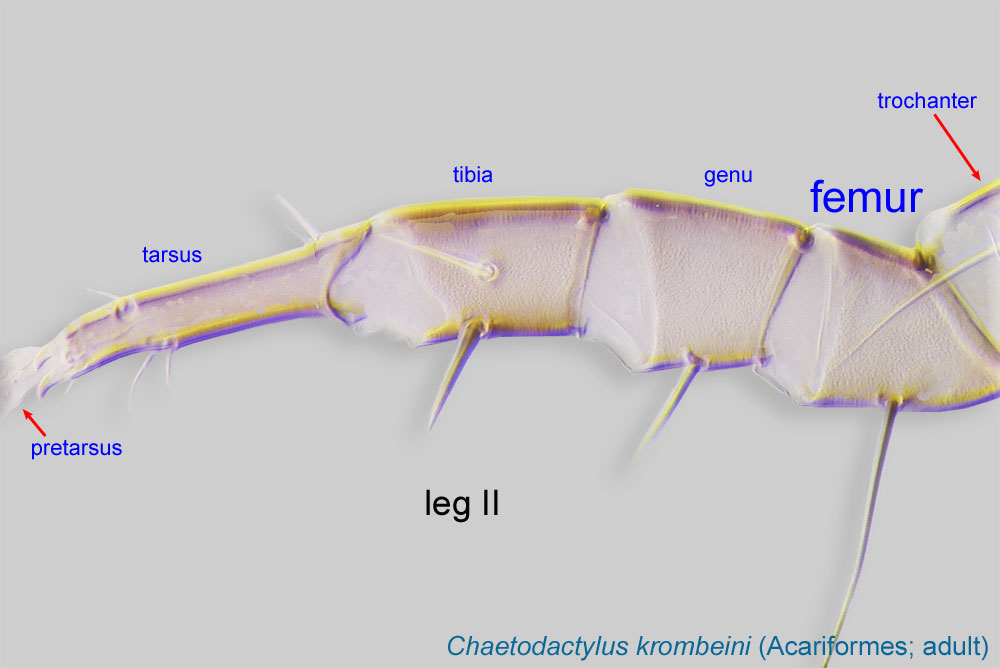 I with 4 setae, femurfemur:
I with 4 setae, femurfemur:
Leg or palp segment (also known as podomere or palpomere) between genu and trochanter. In ParasitIformes can be subdivided into telofemur and basifemur.
 II with 3 setae (Fig. 2). Dorsal gnathosomal setae filiform (Figs. 1, 3). Dorsal setae of idiosomaidiosoma:
II with 3 setae (Fig. 2). Dorsal gnathosomal setae filiform (Figs. 1, 3). Dorsal setae of idiosomaidiosoma:
Body not including the gnathosoma.
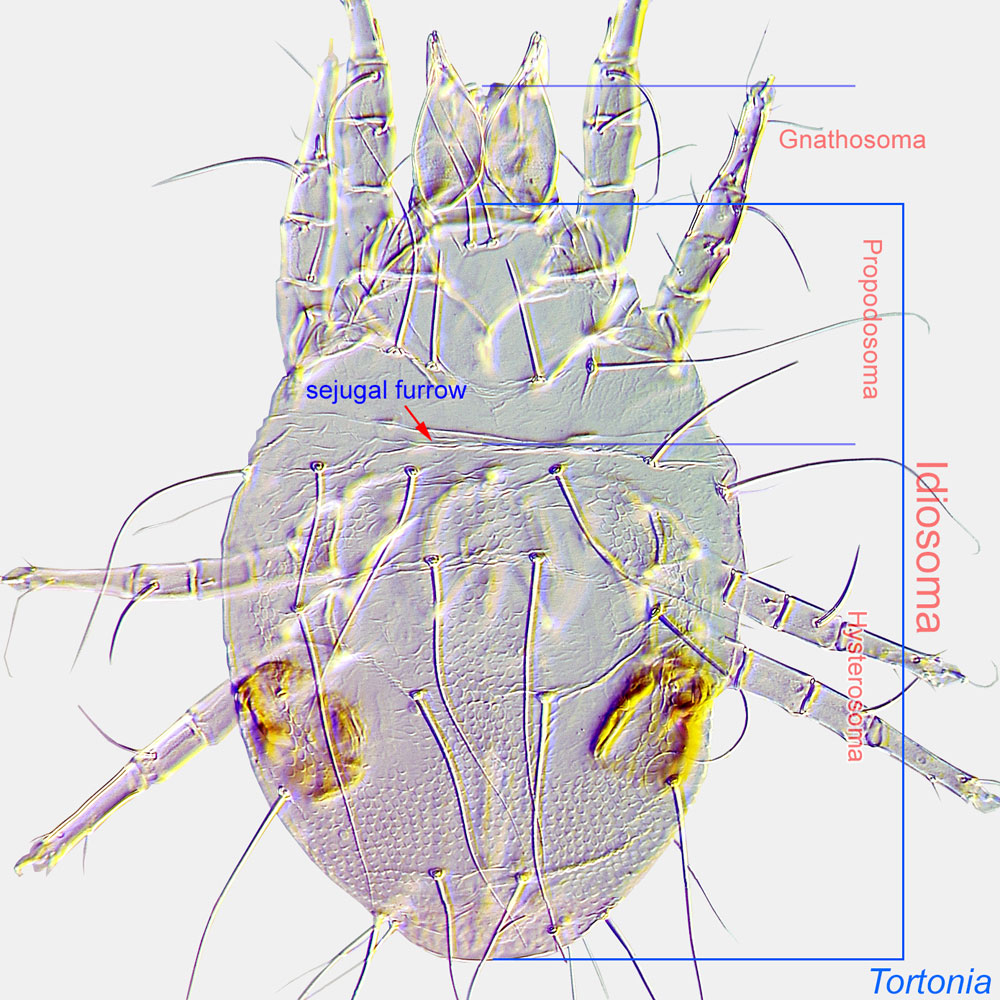 simple, unmodified, short (Fig. 1). Gnathosomal capsule not conspicuously beaklike (Fig. 2).
simple, unmodified, short (Fig. 1). Gnathosomal capsule not conspicuously beaklike (Fig. 2).
Female: Claw I present, not enlarged (Figs. 1, 3). Ambulacrumambulacrum:
The claws and empodium of the apotele or pretarsus.
I developed (Figs. 1, 3). Prodorsumprodorsum:
Dorsal surface of propodosoma.
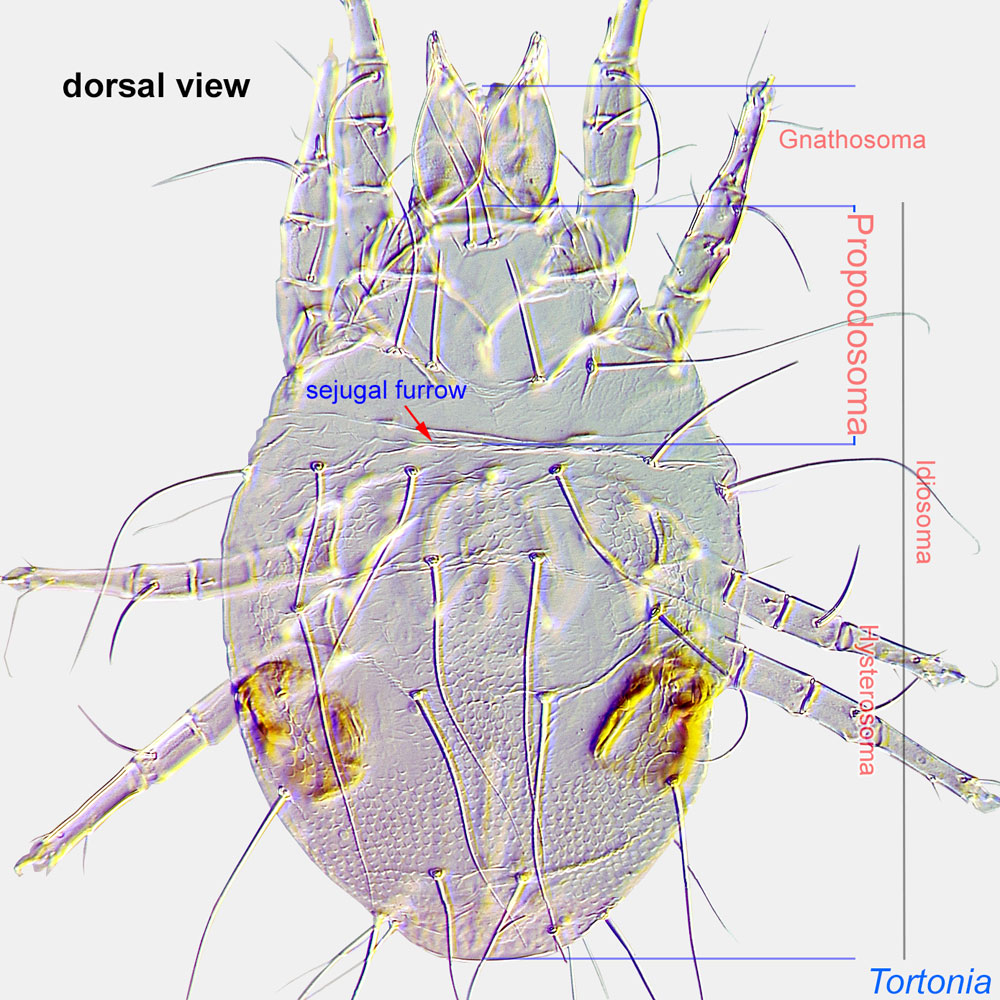 with a pair of capitate trichobothriatrichobothrium:
with a pair of capitate trichobothriatrichobothrium:
Modified seta that can be distinguished from true seta by its distinct large socket (complex cup-like cavity), and often, shape (which may be filiform, ciliate, pectinate, or thickened or clubbed). Present in many Acariformes (except Astigmata) and Opilioacarida (Parasitiformes). When paired and situated on the propodosoma, termed "prodorsal."
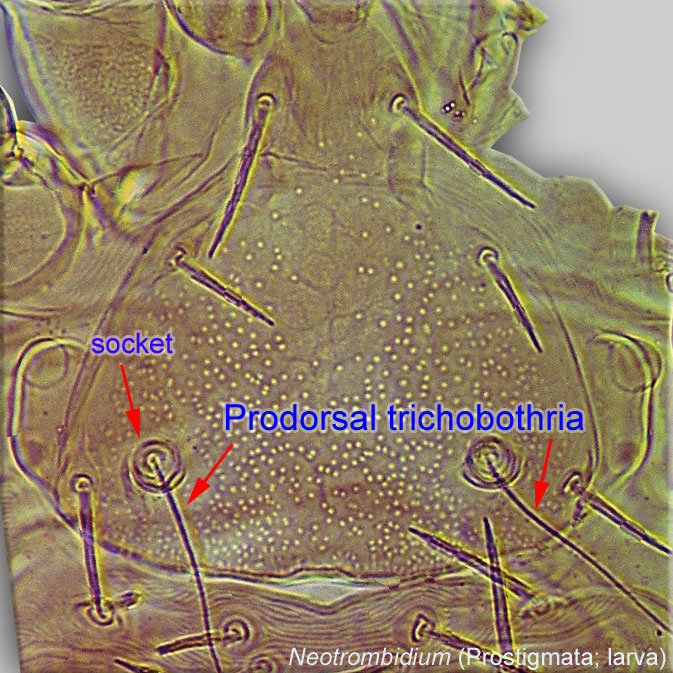 (Figs. 1, 3). Tegulategula:
(Figs. 1, 3). Tegulategula:
Lobe-like to acuminate cuticular plate projecting posteriorly between coxae IV in Tarsonemidae. Also used for hinged sclerite covering the wing bases in bees.
short, not elongated, truncated (Fig. 2). Pharynxpharynx:
A muscular ectodermal structure that opens into a buccal cavity or mouth, and serves as a suction pump for ingesting food materials. In certain Heterostigmata pharyngal musculature is subdivided into 2-3 distinct parts.
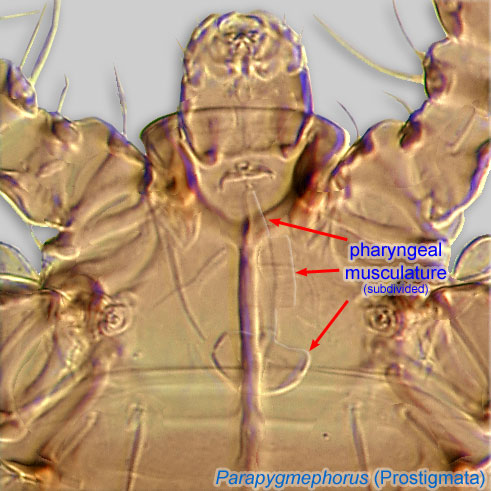 not conspicuously enlarged (Figs. 1, 3). Setae sc2 well posterior to stigma, not longer than other setae (Figs. 1, 3). Stigmata situated closely anterolaterad of vertical setae v1 on hornlike protuberances by edge of prodorsalprodorsal:
not conspicuously enlarged (Figs. 1, 3). Setae sc2 well posterior to stigma, not longer than other setae (Figs. 1, 3). Stigmata situated closely anterolaterad of vertical setae v1 on hornlike protuberances by edge of prodorsalprodorsal:
Pertaining to the prodorsum.
shield (Figs. 1, 3). ApodemesApodeme:
Internal sclerite that serves as an attachment site for muscles. Most commonly used (as "coxal apodeme") to describe elements of coxae fused to the ventral body in Acariformes (coxae are free and not fused to the body in Parasitiformes), and may be variously referred to as ventral, sternal, anterior, or posterior.
 4 extending posterolaterally to bases of trochanterstrochanter:
4 extending posterolaterally to bases of trochanterstrochanter:
Leg or palp segment (also known as podomere or palpomere) between femur and coxa. In Acariformes this is the most basal movable leg segment (or podomere) forming a joint with the body.
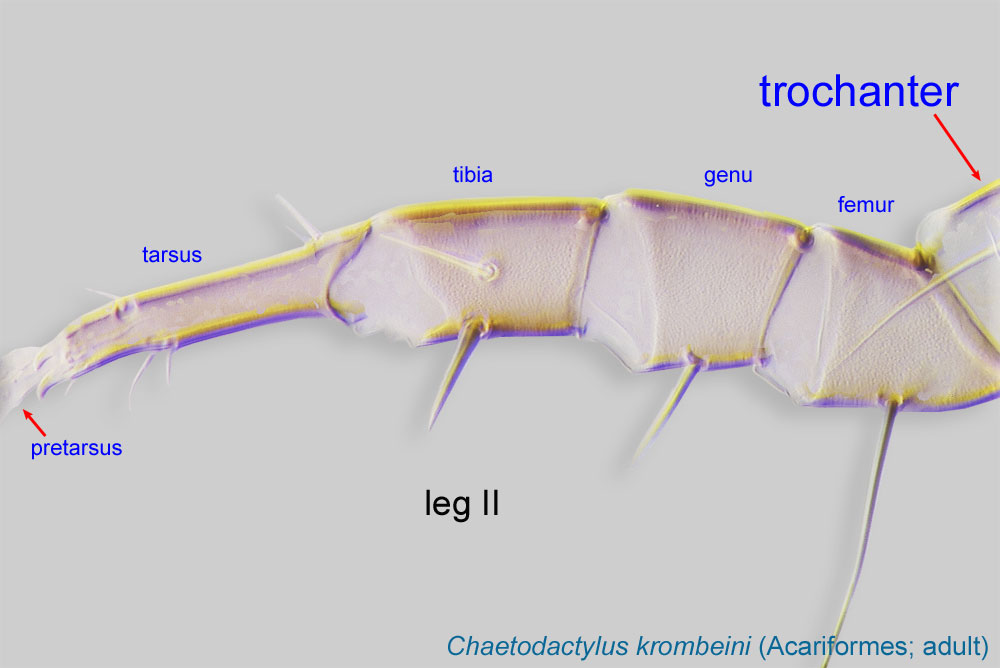 IV (Fig. 2).
IV (Fig. 2).
The two described species can be identified using Ochoa et al., 2003Ochoa et al., 2003:
Ochoa, R., J. S. Pettis amp; O. M. Mireles. 2003. A new bee mite of the genus Pseudacarapis (Acari : Tarsonemidae) from Mexico. International Journal of Acarology 29: 299-305..
Pseudacarapis differs from Tarsonemus by scapular setae sc2 not longer than others (sc2 distinctly longer than other setae in Tarsonemus); stigmata situated closely anterolateral of vertical setae on hornlike protuberances by edge of prodorsalprodorsal:
Pertaining to the prodorsum.
shield (stigmata situated posterior to v1 and stigmata and v1 are not very close to each other; protuberances bearing stigmata absent in Tarsonemus); apodemesapodeme:
Internal sclerite that serves as an attachment site for muscles. Most commonly used (as "coxal apodeme") to describe elements of coxae fused to the ventral body in Acariformes (coxae are free and not fused to the body in Parasitiformes), and may be variously referred to as ventral, sternal, anterior, or posterior.
 4 extending posterolaterally to bases of trochanterstrochanter:
4 extending posterolaterally to bases of trochanterstrochanter:
Leg or palp segment (also known as podomere or palpomere) between femur and coxa. In Acariformes this is the most basal movable leg segment (or podomere) forming a joint with the body.
 IV (not reaching bases of trochanterstrochanter:
IV (not reaching bases of trochanterstrochanter:
Leg or palp segment (also known as podomere or palpomere) between femur and coxa. In Acariformes this is the most basal movable leg segment (or podomere) forming a joint with the body.
 IV in Tarsonemus); tegulategula:
IV in Tarsonemus); tegulategula:
Lobe-like to acuminate cuticular plate projecting posteriorly between coxae IV in Tarsonemidae. Also used for hinged sclerite covering the wing bases in bees.
truncated (rounded in Tarsonemus).
India, Japan, China (Pseudacarapis indoapis), and Mexico (Pseudacarapis trispicula). Note that the record of P. indoapis from Egypt (Abou Senna, 1997Abou Senna, 1997:
Abou Senna, F. M. 1997. A new record of phoretic mites on honey bee Apis mellifera L. in Egypt. Journal of the Egyptian Society of Parasitology 27: 667-80.) is a misidentification.
honey bees (Apis)
permanentpermanent:
associated exclusively with bees or their close relative, wasps; cannot live without these hosts
Phoretic phoretic:
Pertaining to phoresy; using another organism (i.e., a host) for dispersal to new habitats. Phoresy can be distinguished from parasitism because feeding typically does not occur during phoresy.
females of Pseudacarapis indoapis prefer being on the neck and in or near the posterior tentorial pits of the host, where 2-14 mite individuals can occur. Males and larvae have been found only in beehives (Sumangala, 1999Sumangala, 1999:
Sumangala, K. 1999. Ecobiology of Pseudacarapis indoapis (Acari: Tarsonemidae) - 1. Nutrition, dispersal and host range. Entomon. 24: 235-239.). Based on cheliceral morphology, this species is not a parasite, but probably a pollen-feeding commensal (Lindquist, 1968Lindquist, 1968:
Lindquist, E. E. 1968. An unusual new species of Tarsonemus (Acarina: Tarsonemidae) associated with the Indian honey bee. Canadian Entomologist 100: 102-106.). Direct observations indicated that provisioned food or fungus is the food source for this mite species (Sumangala, 1999Sumangala, 1999:
Sumangala, K. 1999. Ecobiology of Pseudacarapis indoapis (Acari: Tarsonemidae) - 1. Nutrition, dispersal and host range. Entomon. 24: 235-239.). In Japan, it has been found in dying queenless colonies (Sakai and Sasaki, 1989Sakai and Sasaki, 1989:
Sakai, T. amp; M. Sasaki. 1989. Tarsonemus indoapis (Acarina: Tarsonemidae) from Japanese honeybee, Apis cerana japonica . Honeybee Science 10: 37-38.).